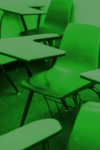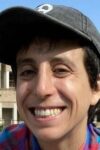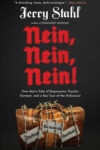Prelude
The first protest I attended after Donald Trump’s inauguration was UC Berkeley’s J20 Coalition march from Sproul Plaza to Oakland’s Oscar Grant Plaza. Several hundred students took part. Police in riot gear were visible, but tame for the time. We proceeded along at a brisk pace. The chants were joyful, but they could not mask a palpable feeling of foreboding among the student protesters.
On the next day, a few friends and I partook in the Women’s March in Oakland. It was a little bit boring: The tightly packed congregation around Lake Merritt crawled forward at a snail’s pace. Police tried to make themselves invisible. The signs I saw were often more cheeky than outraged. People raised placards with jokes about the size of Trump’s hands written on them, and there were more than a few strange, pop-culture references to fictional characters, like Princess Leia. Much has already been written about the politics of the marchers, and I have nothing to add.
The size of the crowd was remarkable, but not so remarkable that it dispelled my apprehension that America was stumbling into a particularly dark era. The aerial images of the marches in Oakland and other cities across the nation brought to mind similar photographs of the massive February 15, 2003 Iraq War protests. The New York Times famously described the millions of antiwar protesters who took to the streets on that day as a “second superpower” impeding the advance of a rogue administration. Yet, the war started a few weeks later and the mass demonstrations petered out. As I headed back to my apartment and reflected on the pictures of the pinkish masses in our nation’s streets, I wanted to believe that, this time, a second superpower had emerged in earnest. But I was unsure.
Six days later, on January 27, Trump signed Executive Order 13769, which is often colloquially referred to as “the Muslim Ban.” Given the negligible influence that the refugees and the minorities affected by the ban have upon American politics I did not expect much in the way of an expression of solidarity. I was wrong. On January 28, protests erupted against the Trump administration and its Muslim Ban at international airports across the country.
I joined the SFO demonstration with members of Berkeley’s International Refugee Assistance Project. The scenes at the airport were genuinely moving. Over the course of the day protesters marched from the street outside the arrivals terminal towards the international security check point. They chanted, “let them out, right now!” on behalf of travelers detained due to the ban. Iraqi, Iranian, and Palestinian women and men delivered speeches highlighting the links between the present ban and the past excesses of American foreign policy. Airport security and police mostly seemed stunned by the event.
The post-9/11 authoritarianism that my generation has come to view as normal was born in our nation’s airports. I wondered if our peculiar mix of Islamophobia and deference to the state on national security issues might finally die at our airports. At SFO, there was a sense that we had come full circle.
Rage in Berkeley
I began my day on February 1 skeptical of the planned “No Milo Yiannopoulos” campus demonstration. I had no illusions about the man my peers were about to protest. “Fascist” is the only word that really fits the Breitbart editor’s politics: his theatrical vulgarity, his deference to power, his misogyny, and his racism. Euphemisms like “troll” or “provocateur” are politically correct substitutes for the more caustic and precise term.
Yet, I was concerned that the protest would be too serious and too sentimental. Milo is an able stage manager. He rallies his followers by deftly recasting justified moral indignation as evidence of coddling and bourgeoisie decadence. Appeals to a common moral sensibility are not an antidote to his flavor of fascism. Ridicule in the mold of real provocateurs, like Noël Godin, is the cure. Perhaps some students will laugh Milo out of a room one day, but that is not what happened on February 1.
The demonstration at Cal was not defined by absurdist mockery. And it also was not overly sentimental. Instead, unbridled rage was the order of the day. This was a strange surprise to me at first. The anger I saw erupt around our Student Union building was too intense for a man as small as Milo. But I soon realized that this was not really a protest against a far-right speaker. The real target of my peers was Donald Trump. And they struck their target. The students captured the attention of the President and the country. In doing so, they shifted my view of the possibilities and the risks of our vexing political moment.
Setting Up
Much of the action on the night of the protest unfolded on a portion of the UC Berkeley campus called Upper Sproul Plaza. Decades ago Mario Savio, one of the icons of the Free Speech Movement, delivered speeches on the steps of a large building called Sproul Hall. The neoclassical structure with a brick-red roof is adjacent to the eastern side of Upper Sproul. On the Plaza’s western border one can find the MLK Student Union building and steps leading 12 feet down to another public square called Lower Sproul Plaza. Milo was scheduled to speak at the MLK building at 7:30 pm. Instead, armed police would spend about two hours using the eastern balcony of the three-story, glass-and-cement stronghold to confront protestors.
When I first walked through Sproul at around 5:40 pm the scene seemed to confirm my presumption that the crowd would not be particularly large and that the protest would be somewhat corny. I doubt there were more than a few hundred protesters out at the time. They were demonstrating around the MLK building in clumps, each with distinctive flags and banners. Most were young. One small assemblage was holding up a large red flag emblazoned with the likeness of Che Guevara. The largest group I saw on Upper Sproul was pressed up against the northern portion of a metal police barricade that had been set up along the perimeter of the MLK building. A young woman with short black hair and a megaphone was leading this group’s chants. She declared that they would block the building’s exits to prevent Milo from entering.
Having had enough after less than twenty minutes, I decided to leave. The sky was darkening as I walked through Lower Sproul. I passed a middle-aged clump of protestors from Bob Avakian’s cult near the southwestern corner of the MLK building, and then, something caught my eye. Six or so young men were setting up barricades, directing traffic, and lighting fires in the middle of Bancroft Way, a two-lane street that borders the southern side of our campus. At that point it was clear to me that whatever was about to happen on Sproul that night, it was not going to be corny.
Battle for Sproul Plaza
As I turned around and made my way to the stairs separating Lower and Upper Sproul I heard a loud bang that I soon realized was a firework. My walk over to Upper Sproul was interrupted again when about a dozen fully equipped riot police came pouring out of a tunnel to my north. They headed into a first-floor entrance on the north side of the MLK building. A bearded protester with a sign by his side was running after them and screaming something I could not hear.
I paused for a moment and then kept walking. A plume of smoke rose from Upper Sproul. Someone set off a fire alarm. Fireworks crackled with greater frequency and intensity. The barricades I had seen earlier had been dismantled, and the chanting crowd began to swell. A handful of police made their way to the eastern balcony of the MLK building, and I saw one of these officers pointing a gun at the, now large, mass of protestors.
With tensions escalating between police and demonstrators, two new groups interspersed amid the students became more conspicuous. First, various television crews were descending upon campus. In the chaos that was engulfing Upper Sproul major news outlets saw opportunities. Cameramen tended to drift towards the most tumultuous scenes on the plaza. This was no surprise. The adage “if it bleeds, it leads” is familiar to most. Still, as a bystander watching network news teams at work, I became more sensitive to the vulgarity of their enterprise. Dan Gilroy’s Nightcrawler came to mind. An event that felt formless and complex to participants was being clipped and simplified for mass consumption.
The other prominent newcomers to the demonstration were masked protesters entirely clad in black. Over a decade ago, Matt Taibbi opined that if marchers at a major demonstration could muster, “the unity and discipline to dress alike,” they might cause a national panic. It’s possible that the matching outfits of these “Black Bloc” protesters contributed to some of the unease with what occurred in Berkeley on February 1. But I do not think that the color coordination entirely explains the anxieties stirred at the national level.
These folks came to the university ready for a street fight. Some were armed with large yellow poles, some wore helmets and brandished shields, others were entirely unarmed and vulnerable. Once I made it to Upper Sproul I could see that they had rammed a dismantled barricade into the window of an Amazon store housed in the northeastern corner of the MLK building. Someone had spray painted and crossed out “Milo” on a toppled floodlight in front of the store.
A Black Bloc group was also responsible for the fireworks that I first heard at a distance. The rockets were being discharged in the direction of the MLK building’s eastern balcony, and, most likely, at the police stationed there. Occasionally a particularly large firework would go off with a roar in midair. These louder explosions would send the crowd of well over a thousand people into a panic, but cooler heads among them would yell “don’t run!” in order to prevent injuries.
The crowd was also startled when police fired projectiles from the eastern balcony. But there were not many officers present, and a few volleys from them every now and then would do little to disperse the gathering. Someone eventually ignited the floodlight with Milo’s name painted on it. The resulting bonfire became the centerpiece of much of the news coverage that followed.
The cancelation of the event was announced at around 6:15 pm and soon thereafter police issued dispersal orders from the balcony. The officers threatened to use “less lethal munitions” and “chemical agents” against protesters and bystanders in Upper Sproul within ten minutes. Yet, the people gathered in the plaza did not move. Perhaps they did not believe the announcement canceling Milo’s speaking engagement. Perhaps they doubted whether a limited number of cops would have the resolve to fire anything into the agitated multitude below. Angry chants, including “don’t come back!” continued on.
Some time passed and eventually someone with access to a microphone and an amplifier began to speak. I believe he was a Black Bloc protester. He was not far from the charred floodlight. Several red-and-black flags, associated with left-wing variants of anarchism, were raised in his vicinity. He confirmed the cancelation of the Milo event. The announcement ended. “Fuck Donald Trump” by YG & Nipsey Hussle started to blare from the amplifier. The loudest cheer I heard that night followed and a party began on Sproul.
Party
A marching band emerged to put on an impromptu show. The jubilant masses on the plaza danced and shouted with delight as songs by Rihanna played on the amplifier. I started to walk around Sproul and noticed the array of anti-Trump signs in students’ hands. I then recalled that many of the chants throughout the night were not directed at Milo at all. In fact, they were the same slogans that cropped up at the various protests I had attended in the weeks before.
In their analyses of what occurred on Upper Sproul, reasonable people should not ignore the Milo-Bannon-Trump nexus. The right wing propaganda outlet Breitbart is the glue that binds this terrible trio together. I often joke with friends that it’s only a matter of time before Milo replaces the bleary-eyed Press Secretary Sean Spicer. At this juncture in American history it is difficult to envision a demonstration against Milo that is not also an objection to the Trump administration.
As I ambled through the celebration, which had spilled out onto Bancroft Way, I also caught glimpses of violence. A tall, thin, young man in a gray blazer was retching in pain on the south side of the MLK building. White residue covered his face. Apparently a Black Bloc protestor wielding a yellow pole had struck the man in the back before pepper spraying him. The assailant allegedly yelled, “You look like a Nazi!”
A Nazi in a suit? The victim seemed baffled by the attacker’s statement. Many remain unaware that media outlets have popularized the trope of the dapper Nazi in their coverage of Richard Spencer, the Trump supporting white nationalist. The man in the gray blazer was an unlucky passerby, in the wrong place, in the wrong era.
A woman dressed in black tended to the man in gray. Behind a mask, she advised him to avoid smearing the pepper spray. “Try not to touch your face,” she said. The two took a few steps towards the MLK building together.
I should note that the Black Bloc protesters on that night were not a cohesive group. The truth is that Black Bloc is best understood as a tactic, which allows protesters to maintain anonymity and blend in with large groups. In theory, individuals adhering to any political ideology can use the tactic. In actuality, the Black Bloc folks on campus often operated under red-and-black flags.
Other onlookers gathered near the man. I wandered away from the scene and meandered about the Plaza for a while. At approximately 8:00 pm, the party around the MLK building transformed into a southward march down Telegraph Avenue.
Victory March
Much has been made of the divide between the peaceful majority of student protestors and the small minority of Black Bloc radicals who “hijacked” the demonstration. UC Berkeley Chancellor Dirks described the Black Bloc as a group of “Ninja-like” invaders in an email to students.
In fact, there was a clear distinction between the student protestors and the Black Bloc in the bifurcated march down Telegraph. At the rear, entirely peaceful students danced and clapped to a festive tune played by the marching band that emerged on Upper Sproul. The scene was gleeful and kaleidoscopic.
The Black Bloc congregated towards the front of the march. Their amplifier continued to play songs by NWA and Biggie, but hardly anyone was dancing. The austere procession was dimly lit by pink flares and framed by a banner that read “Become Ungovernable.” Among the Black Bloc protesters, those armed with yellow poles seemed most eager to prove their bravado. They smashed emblems of finance (ATM machines) and the national security state (surveillance cameras).
At other points in the night, the divide between the peaceful students and the less peaceful “invaders” did not feel so sharp. There were certainly students who would express their anguish when the Black Bloc would act brazenly. I would hear some cry out “this isn’t right!” and “who is this helping?” when acts of vandalism were committed. But I would also hear cheers. At times, the Black Bloc genuinely felt like a vanguard for the assembly of disgruntled students.
What to make of the vanguardism of the Black Bloc? It may have been more accidental than intentional. Political violence inevitably generates hierarchies. This is a truism. Here, anarchists imposed an ironic hierarchy on an initially uniform mass.
The Trump Era and History’s Circles
I could use this space to condemn the excesses I saw on and around campus on February 1. But condemning students while our new presidential administration continues to express such a wanton disregard for countless human lives seems obscene to me. Jean-Paul Sartre once chided his friend Albert Camus for carrying around “a portable pedestal.” I am presently in no mood to climb up on a moral pedestal.
Still, one can comment on the protest without moralizing. My perspective on the event runs counter to an emerging narrative that ties the fury of my peers to a national tussle over the limits of speech on campus. From my vantage point, the February 1 protest is best understood as an exclamation point that punctuates a series of demonstrations in the Bay Area since the Trump inauguration.
On my way back home that night, I passed a storefront that a rioter had smashed. Two undergraduates were standing in front of the shattered glass, and one asked, “Did Vietnam War protesters break windows like this?” The comment brought to mind the infamous burning of a Bank of America building by Santa Barbara City College students in 1970. A year earlier, students at Cornell, wearing bandoliers and armed with rifles, seized their student union building, Willard Straight Hall. This country has never had a president like Donald Trump, but it has seen campus unrest in its recent history. Presidents who went low, in places like Vietnam, fueled disorder in the nation’s higher education institutions.
The executive branch-induced mayhem of that era gave life to a rising right wing as well. Donald Kagan and Allan Bloom, leading lights of an ascendant neoconservative political current, were galvanized by incidents like the seizure of Willard Straight Hall. Edwin Meese, California’s conservative Attorney General at the time, was also roused by campus turmoil. Riot police under his direction used tear gas and buckshot in an attempt to suppress a violent student demonstration that began on Sproul Plaza in 1969. Officers employing these aggressive crowd-control tactics ended up killing a student named James Rector. Meese went on to become the Attorney General of the country under Ronald Reagan, and, more recently, a member of Trump’s presidential transition team.
This post may contain affiliate links.







